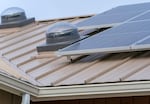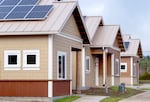In a corner lot between Highway 22 and Grand Ronde Road sit 24 newly built single-family homes. These homes look like many that are being built in Oregon right now as the state tries to address a dire housing shortage, but they have one difference: extreme energy efficiency.
They represent a way that Oregon can build housing for its future, rather than its past; and they will all house a special group of residents, the Confederated Tribes of Grand Ronde’s tribal elders.

Marcela Selwyn checks out the closet space as she tours one of 24 new homes constructed by the Confederated Tribes of Grand Ronde on Dec. 11, 2023, in Grand Ronde. Selwyn has lived in the community for 17 years and will be getting one of these climate-resilient single-family homes in February 2024.
Kristyna Wentz-Graff / OPB
Marcela Selwyn is one of 24 tribal elders getting her home at the Creekside Elder Housing development in February. Selwyn, 80, has lived in the Grand Ronde Community for 17 years. She’s hoping for a home with a nice view near a tree line and a big enough yard for her dog.
“It is just beautiful,” she said as she toured the inside of the nearly finished homes. “It’s beautiful in here.”
Selwyn loved the kitchen layout and appliances, and was in awe of the large bathroom. She noted how much natural light the large windows brought in, but she was especially fond of a feature she had never seen before — sun tunnels.
“I love this because I can see a lot better,” she said, looking up toward the ceiling where shafts of built-in mirrors reflected sunlight to brighten hallways without having to flip a light switch. “I can’t believe how the lighting is. When I came in to peek around, I never knew how much light there was going to be and also the light in the hallway. I love that.”

Grand Ronde Tribal Council member Denise Harvey, left, looks at a sun tunnel in a new home construction on Dec. 11, 2023, in Grand Ronde. The Confederated Tribes of Grand Ronde have built 24 climate-resilient single-family homes for elders in partnership with the Energy Trust of Oregon.
Kristyna Wentz-Graff / OPB
The sun tunnels are one of the many energy-efficient technologies that the Confederated Tribes of Grand Ronde, along with Energy Trust of Oregon, intentionally added to every home to help make them climate resilient and more affordable.
As Oregon attempts to address two challenging issues simultaneously — a severe affordable housing shortage and ambitious climate goals — the partnership between the tribes and Energy Trust is an example of a potential path forward. The groups say projects like the Creekside Elder Housing development offer residents an affordable place to live while staying comfortable during extreme weather ahead.
Climate-resilient homes
Each single-level family home is 1,120 square feet and has two bedrooms and one bathroom, as well as a garage and small yard spaces. They are loaded with energy-efficient technologies in electric appliances, solar panels, renewable energy storage batteries, an electric vehicle charger, heat pumps and electric heat pump water heaters.
“A lot of the efficiencies we talk about are actually hidden that you don’t even see,” said Ryan Webb, the tribes’ engineering and planning manager.
Some of those “hidden” efficiencies include triple pane windows that keep energy bills low in the summer and winter, as well as helping reduce traffic noise from the nearby busy highway. The homes are also heavily insulated, Webb said.

Ryan Webb, engineering and planning manager for the Confederated Tribes of Grand Ronde, says in addition to energy efficiency, a priority was the comfortability of the home. Webb was on hand to show one of the new 24 climate-resilient single-family homes the tribe has built for elders in partnership with the Energy Trust of Oregon.
Kristyna Wentz-Graff / OPB
These mindful changes make a big difference in reducing energy costs. The solar panels could generate enough electricity to power the home throughout the year without tapping into the power grid. The homes also reduce Oregon’s greenhouse gas emissions from the residential and commercial sector, which is the second-largest carbon emitter in the state, according to the Oregon Department of Environmental Quality. Those emissions mostly come from burning fossil fuels to power homes and buildings. In 2021, residential energy use accounted for 16% of the state’s emissions.
The homes also have features that help make the home wildfire resilient, Webb said, like a metal roof and an energy recovery ventilator to help filter out wildfire smoke. The houses can also keep the power on during outages because of the battery storage, a still-rare feature in homes powered by mostly renewable energy.
“That’s the kind of grid resiliency that we try to put into these units,” he said. “If there is something in the surrounding area that’s causing a power outage or some other things, these are still kind of safe and comfortable homes during those times.”

One of 24 energy-efficient and climate-resilient homes constructed by the Confederated Tribes of Grand Ronde, pictured here on Dec. 11, 2023, in Grand Ronde. These homes utilize energy efficient technologies such as solar panels, right, and sun tunnels, center.
Kristyna Wentz-Graff / OPB
Depending on how much energy is used, the batteries could provide power for an average of three hours but could last longer if it’s a sunny day, Webb said.
Intentional from start to finish
Energy-efficient technologies were core to the partnership as the tribes and Energy Trust began to design the homes. The nonprofit organization works with residents, communities and organizations to reduce energy costs and lower greenhouse gas emissions.
While retrofitting older homes with solar or other renewables can be expensive, adding these technologies early in the design process helped cut costs and delay times, Webb said.

New energy-efficient and climate-resilient homes constructed by the Confederated Tribes of Grand Ronde, pictured here on Dec. 11, 2023, in Grand Ronde. Each of the 24 homes is equipped with solar panels, and features such as the metal roof, energy recovery ventilator and siding materials help make the homes wildfire resilient.
Kristyna Wentz-Graff / OPB
“There was a lot more intentional conversations with our architect, with the Energy Trust of Oregon and they provided a fantastic resource to us. Really being able to review the designs and making sure that we are doing things in that intentional way,” he said. “From a design standpoint, it really didn’t add any time and I don’t think it really added any cost to do all of that.”
From start to finish, the cost for constructing all 24 homes was a little over $9 million, or around $375,000 each, Webb said. The tribes received $25,000 in incentives from Northwest Energy Efficiency Alliance to help pay for the triple-pane windows.
Adding solar and battery storage capacity added about $800,000 toward the complete cost. The tribes received more than $220,000 in incentives from the Oregon Department of Energy.
The tribes also received help from a solar incentive program through the Energy Trust of Oregon. It was the jolt needed to begin constructing what the nonprofit calls net-zero homes, said residential program manager Scott Leonard.
“Energy Trust offered above $300,000 in incentives to Grand Ronde for all 24 homes,” he said.

Electric vehicle chargers are included in a new home construction, pictured here on Dec. 11, 202,3 in Grand Ronde.
Kristyna Wentz-Graff / OPB
Leonard said the organization works with several builders within their service territory and that Grand Ronde’s design to add solar paired with batteries was rare.
“It is not common to see solar plus storage put into new construction right off the bat. Sometimes people make them solar ready or storage ready and then the homeowner makes the decision,” he said. “What Grand Ronde decided to do was install them during construction. So that’s not common.”
Overall, the Tribes’ intentional planning and goals saved money in construction, Leonard said, adding that an energy-efficient home is a goal anyone can achieve.
“I think it’s important for everyone to know that this can be done,” Leonard said.
The organization is working with other tribes and communities to build housing projects that will replicate what Grand Ronde was able to achieve.
Building for future generations
The idea of creating climate resilient homes was not always at the top of mind, Tribal Council member for the Confederated Tribes of Grand Ronde Denise Harvey said. In fact, energy efficiency was not a priority in the past due to the costs, she said.
“As things have changed and we’ve all learned more about climate change and the effects of that and the energy efficiency opportunities [that] come up, we try and do this with all of our new construction,” she said.

Grand Ronde Tribal Council member Denise Harvey, left, and future resident Marcela Selwyn tour one of 24 new homes constructed by the Confederated Tribes of Grand Ronde on Dec. 11, 2023, in Grand Ronde. Selwyn has lived in the community for 17 years and will be moving into one of these climate resilient single-family homes in early 2024.
Kristyna Wentz-Graff / OPB
Harvey hopes the new homes will not only help tribal elders lower their energy bills but also bring a climate benefit to their whole community and inspire others to do the same. She hopes the switch to an all-electric home can begin to change people’s minds about climate change while creating better habits in home construction.
“I think it’s just over time where you show people, you educate them, they experience it and then it’s something that they’ve learned, something that’s new, something they transfer down to their children, their grandchildren,” she said.

